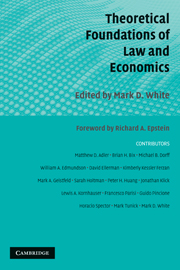Book contents
- Frontmatter
- Contents
- Foreword
- Preface
- Notes on Contributors
- PART ONE THE ROLE AND USE OF ECONOMICS IN LEGAL STUDIES
- PART TWO EFFICIENCY
- 5 Efficiency, Practices, and the Moral Point of View: Limits of Economic Interpretations of Law
- 6 Numeraire Illusion: The Final Demise of the Kaldor–Hicks Principle
- 7 Justice, Mercy, and Efficiency
- PART THREE RATIONALITY AND THE LAW
- PART FOUR VALUES AND ETHICS IN CIVIL AND CRIMINAL LAW
- Index
- References
6 - Numeraire Illusion: The Final Demise of the Kaldor–Hicks Principle
Published online by Cambridge University Press: 06 July 2009
- Frontmatter
- Contents
- Foreword
- Preface
- Notes on Contributors
- PART ONE THE ROLE AND USE OF ECONOMICS IN LEGAL STUDIES
- PART TWO EFFICIENCY
- 5 Efficiency, Practices, and the Moral Point of View: Limits of Economic Interpretations of Law
- 6 Numeraire Illusion: The Final Demise of the Kaldor–Hicks Principle
- 7 Justice, Mercy, and Efficiency
- PART THREE RATIONALITY AND THE LAW
- PART FOUR VALUES AND ETHICS IN CIVIL AND CRIMINAL LAW
- Index
- References
Summary
INTRODUCTION: PARETO VERSUS MARSHALL–PIGOU–KALDOR–HICKS
The Paretian revolution in normative economics established the possibility of defining efficiency (i.e., Pareto optimality, wherein no one can be made better off without making someone else worse off) without using interpersonal comparisons of utility or preferences. This treatment of efficiency is often seen as a weak form of a utilitarian or welfarist theory, that is, as a necessary condition for a maximum of “social welfare.” But the notion of Pareto efficiency can also be seen as part of a rights-based approach to normative economics that takes seriously the differences between persons and that accordingly eschews any given social scalar (“social welfare”) that morally ought to be maximized. Without any such scalar quantity to be maximized, the Paretian conditions are the necessary conditions for a vector maximization of the individual welfares.
The older Marshall–Pigou tradition in the economics of welfare was based on a fundamental distinction between the size and the distribution of the “social pie,” for example, Pigou's “production” versus “distribution” of the “national dividend.” This social pie was not to be identified with overall welfare (e.g., Pigou's “economic welfare”), because the quantity of overall welfare could be affected by both the size and the distribution of the pie (e.g., Pigou's “national dividend”). The pie that economists would be professionally concerned with maximizing is an intermediate aggregate expressed in the measure of money and variously known as the national dividend (or product), net social benefits (e.g., in cost–benefit analysis), or social wealth (e.g. in the law-and-economics literature).
- Type
- Chapter
- Information
- Theoretical Foundations of Law and Economics , pp. 96 - 118Publisher: Cambridge University PressPrint publication year: 2008
References
- 2
- Cited by



